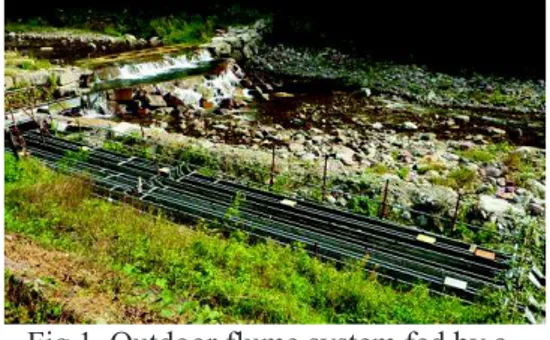ALAN 2016
4
thInternational Conference on Artificial Light at Night
September 26-28, Cluj-Napoca, Romania
Conference Handbook
Edited by Christopher CM Kyba Dorin Beu Sibylle Schroer Franz H¨olker Johanne RobyALAN 2016
Artificial light at night affects biomass and community composition of freshwater primary producers
Theme: Biology & Ecology
Maja Grubisic*1,2, Gabriel Singer1, Roy H.A. van Grunsven1,
Michael T. Monaghan1, Maria C. Bruno3, Alessandro Manfrin1,2,Franz Hölker1
1
Leibniz-Institute of Freshwater Biology and Inland Fisheries, Berlin, 12587, Germany
2
Institute of Biology, Freie Universität Berlin, Berlin, 14195, Germany
!
"#$%&'()$%*"+&,-%&".'/01"2*3*'4/0"'%&"5%%$6'7)$%"8*%7*41"San Michele all’Adige, 38010," 57'9:
Introduction
Artificial light at night is recognized as a contributor to environmental change at the global scale (Cinzano et al. 2001) and a biodiversity threat (Hölker et al. 2010). Increasing research efforts have demonstrated numerous adverse effects on aquatic and terrestrial animals (e.g. Moore et al. 2000, Perkin et al. 2014), microorganisms (Poulin et al. 2013, Hölker et al. 2015), and plants (Bennie et al. 2015). Aquatic primary producers, however, have rarely been studied and the impacts on benthic autotrophs are poorly understood.
Benthic autotrophs, such as diatoms, green algae and cyanobacteria, grow attached to underwater surfaces and form the basis of the food web in many streams and clear, shallow waters (Stevenson 1996). They use light both as a source of energy for photosynthesis and growth, and as an information cue for the regulation of physiological processes, especially those that display a circadian rhythm (Kianianmomeni & Hallmann 2014). Further, the major autotroph groups differ in their preferences for light conditions (Richardson et al. 1983), therefore the alteration in light regimes may cause changes in community composition.
We conducted experiments in two different freshwater systems: an outdoor flume system mimicking a sub-alpine stream (Bruno et al. 2016, Fig.1) and a low-land agricultural drainage ditch, the Westhavelland experimental site (Holzhauer et al. 2015, Fig.2). We simulated the night-time light conditions of a waterbody in a light-polluted area (approx. 20 lux at the water surface), and compared the biomass and community composition with those grown under natural nights. The experiments were performed in different seasons in both ecosystems in order to account for
seasonal differences in community composition. Two light sources, warm-white LEDs and high-pressure sodium (HPS) lamps, were used in the experiments in the Westhavelland site while only warm-white LEDs were used in the sub-alpine stream.
Fig 1. Outdoor flume system fed by a pristine sub-alpine stream
Fig 2. Low-land agricultural drainage ditch
ALAN 2016
The LED-based nighttime illumination over three to six weeks resulted in a decrease of autotroph biomass in both aquatic systems. Community composition was also affected by LED, but the effect varied between the systems, seasons and developmental stage of the community. Primary producers did not respond to HPS-based illumination, likely a result of different spectral composition. Our results show that artificial light can have profound effects on the primary producers of aquatic ecosystems. By negatively affecting the biomass and altering community composition, artificial light at night may hinder primary production as a vital ecosystem function and therefore negatively impact the resilience of aquatic ecosystems. This effect is likely to increase with the current shift from sodium lights to white LED.
References
Bennie J, Davies TW, Cruse D, Inger R, Gaston KJ (2015) Cascading effects of artificial light at night: resource-mediated control of herbivores in a grassland ecosystem. Phil Trans Roy Soc B, 370(1667), 20140131.
Bruno MC, Cashman MJ, Maiolini B, Biffi S, Zolezzi G (2016) Responses of benthic invertebrates to repeated hydropeaking in semi-natural flume simulations. Ecohydrology, 9, 68-82.
Cinzano P, Falchi F & Elvidge CD (2001) The first World Atlas of the artificial night sky brightness. Mon Not R Astron Soc, 328, 689-707.
Holzhauer SI, Franke S, Kyba C, Manfrin A, Klenke R, Voigt CC, Lewanzik D, Oehlert M, Monaghan MT, Schneider S, Heller S, Kuechly H, Brüning A, Honnen AC, Hölker F (2015) Out of the Dark: Establishing a Large-Scale Field Experiment to Assess the Effects of Artificial Light at Night on Species and Food Webs. Sustainability, 7(11), 15593-15616.
Hölker F, Wolter C, Perkin EK, Tockner K (2010) Light pollution as a biodiversity threat. Trends Ecol Evol, 25(12), 681-682.
Hölker F, Wurzbacher C, Weissenborn C, Monaghan MT, Holzhauer SIJ & Premke K (2015) Microbial diversity and community respiration in freshwater sediments influenced by artificial light at night. Phil Trans Roy Soc B, 370(1667), 20140130
Kianianmomeni A, Hallmann A (2014) Algal photoreceptors: in vivo functions and potential applications. Planta, 239, 1-26.
Moore MV, Pierce SM, Walsh HM, Kvalvik SK, Lim JD (2000) Urban light pollution alters the diel vertical migration of Daphnia. Verh Internat Verein Limnol 27: 779–82.
Perkin EK, Hölker F, Tockner K (2014) The effects of artificial lighting on adult aquatic and terrestrial insects. Freshwater Biol, 59(2), 368-377.
Poulin C, Bruyant F, Laprise MH, Cockshutt AM, Vandenhecke JMR, Huot Y (2014) The impact of light pollution on diel changes in the photophysiology of Microcystis aeruginosa. J. Plankton Res 36, 286-291.
Richardson K, Beardall J, Raven JA (1983) Adaptation of Unicellular Algae to Irradiance: An Analysis of Strategies. New Phytologist, 93, 157-191.
Stevenson RJ (1996) An Introduction to Algal Ecology in Freshwater Benthic Habitats. In: Algal Ecology: Freshwater benthic ecosystem pp. 3-30. Academic Press, San Diego.
